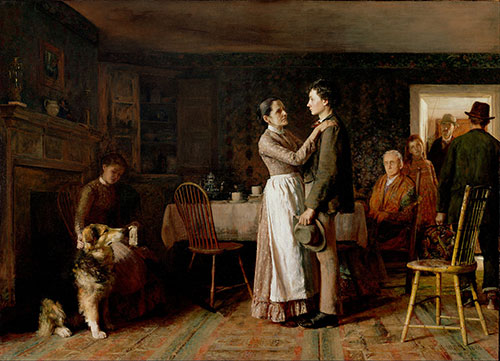
"Breaking Home Ties," Thomas Hovenden. Image courtesy of Wikimedia Commons.
In 1893, 27 million visitors came to Chicago for the World’s Columbian Exposition- almost one quarter of the population of the United States. An astonishing number made their way to view "Breaking Home Ties", a sentimental genre painting by Thomas Hovenden. Millions viewed Hovenden’s sentimental depiction of a rural lad and his aging mother exchanging goodbyes as he prepared to leave the family homestead for the wide world. By far the most popular painting at the fair, the viewing area in front of the large painting was “always jammed” and the foot traffic was so high the carpet in front of the painting had to be replaced numerous times. Observers noted that older men especially were strongly moved, sometimes to tears, as they interacted with the painting, confessing “I have been right there.”
Hovenden’s painting was powerful because it reconnected Americans with a scene that took place over and over in homes and communities throughout the 19th century. The decades following the American Revolution unleashed ambitions of a rising generation of citizens determined to “get ahead.” Nowhere in the nation was this effect more pronounced than in New England, where the young French traveler Alexis de Toqueville noted with astonishment the boundless enthusiasm and ambition of ordinary people: “When all prerogatives of birth and fortune are abolished, when all professions are open to all and a man’s own energies may bring him to the top of any of them, an ambitious man may think it easy to launch on a great career and feel that he is called to no common destiny.”
This optimistic self-confidence buoyed young Edward Hitchcock as he looked beyond his father's workshop and the family farm in Deerfield, Massachusetts, to a wider world. The family had long been aware of Edward’s intellectual promise, particularly in the sciences, and Justin Hitchcock stretched thin family finances to send his children to the local academy. Edward thrived at the school, where he would become a teacher and preceptor (headmaster). Engaged in a continual course of self-improvement and religious inquiry, he became a Congregational minister as well as one the nation’s most prominent early geologists. Throughout his career, he entwined a strong moral sensibility with a tireless devotion to research and scientific inquiry.
The moral underpinnings of Hitchcock’s rise from rural obscurity to national and international prominence were a key feature of the era’s ideal of success. Nowhere does the 19th century vision of success come through more clearly than in the novels of Horatio Alger. A Massachusetts clergyman, Alger became famous for his “rags to riches” stories of poor but virtuous, hardworking teen-aged boys who attracted the attention of benevolent patrons.
The Yankee ambition to attain economic prosperity and sociability that inspired a generation to "break home ties" did not assure success. Alexis de Tocqueville also observed how, “at every step [ambitious Americans] find immense obstacles which they had not at first noticed” for, having abolished aristocratic privilege for the few, “they come up against the competition of all.” Commentators were also quick to point out that temptations abounded for young people determined to attain wealth and perhaps fame at any cost. Currier and Ives depicted in their lithograph, "The Ladder of Fortune", a popular metaphor intended to caution as well as inspire those starting their own climb up the ladder. Parents and teachers encouraged young boys and girls to heed the vertical rails labeled “Honesty” and “Morality.” The ladder rose into a tree full of tasty apple-like fruits named “Influence”, “Success”, “Self Respect”, “a good Conscience”, “Contentment”, “Riches” and “The favor of God.” Virtuous young men representing artisans, farmers and tradesmen ascended the rungs of “Industry”, “Temperance”, “Prudence”, “Integrity”, “Economy”, “Punctuality”, “Courage”, and “Perseverance.” Temptations abounded for anyone who fell off the ladder by trying to take morally dubious and potentially disastrous shortcuts to success: “Gambling”, “Lottery”, "Betting”, “Stock Exchange”, and “Strike.”
Thomas Hovenden’s "Breaking Home Ties" spoke volumes to those remembering that emotionally-charged moment when young people left parents and home behind in pursuit of worldly success. The tension between potential successes and pitfalls lay at the heart of 19th century families’ hopes and fears for those who left behind the comforts and moral safeguards of the home circle.